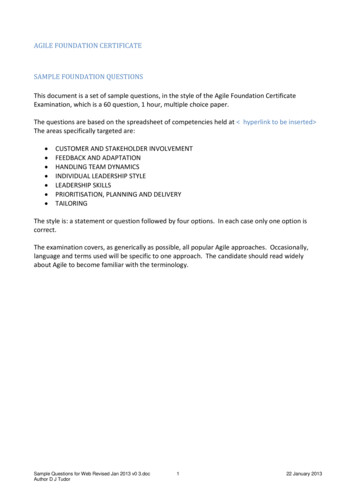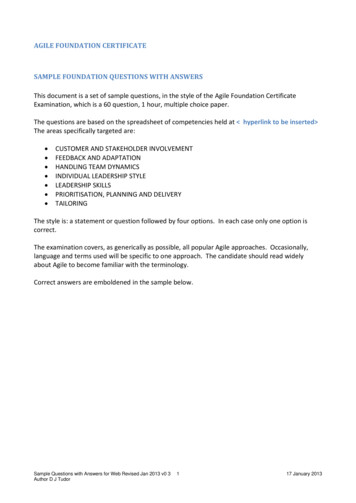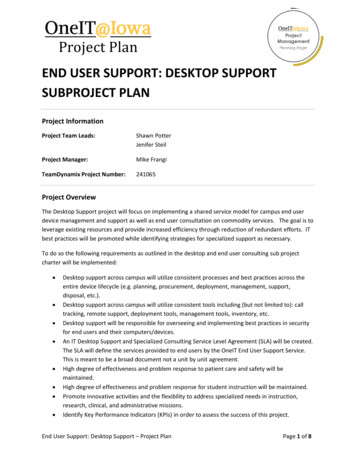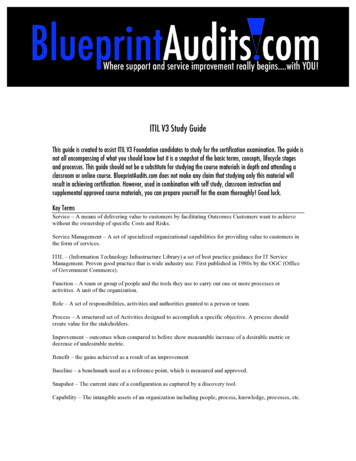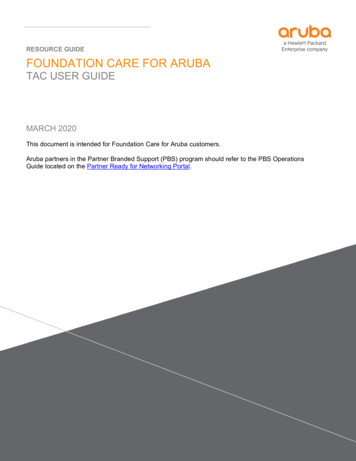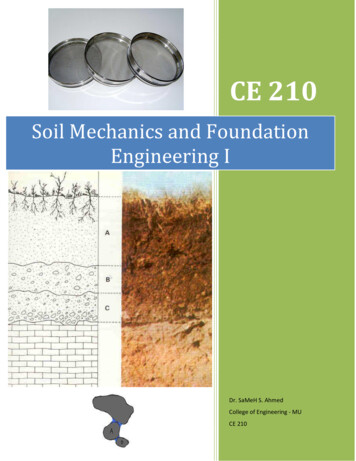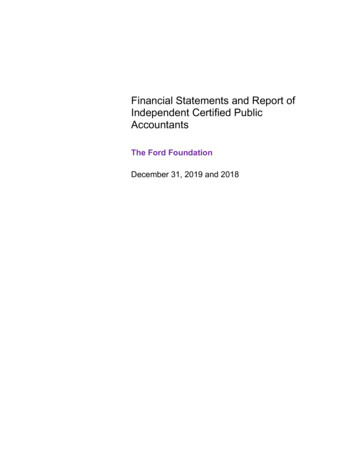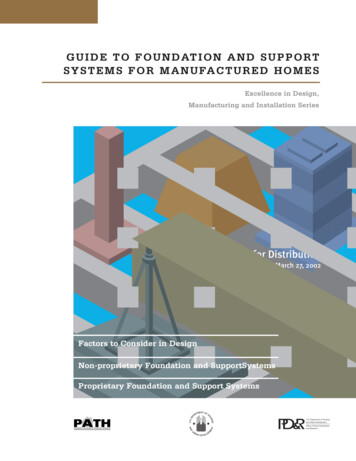
Transcription
G U I D E T O F O U N D AT I O N A N D S U P P O RTS Y S T E M S F O R M A N U FA C T U R E D H O M E SExcellence in Design,Manufacturing and Installation SeriesDRAFT – Not for DistributionMarch 27, 2002Factors to Consider in DesignNon-proprietary Foundation and SupportSystemsProprietary Foundation and Support SystemsU.S. Department of Housingand Urban DevelopmentOffice of Policy Developmentand Research
PATH (Partnership for Advancing Technology in Housing) is a private/public effort to develop, demonstrate,and gain widespread market acceptance for the next generation of American housing. Through the use of newor innovative technologies the goal of PATH is to improve the quality, durability, environmental efficiency, andaffordability of tomorrow’s homes.PATH is managed and supported by the U.S. Department of Housing and Urban Development (HUD). In addi tion, all Federal Agencies that engage in housing research and technology development are PATH partnersincluding the Departments of Energy and Commerce, as well as the Environmental Protection Agency (EPA)and the Federal Emergency Management Agency (FEMA). State and local governments and other participantsfrom the public sector are also partners in PATH. Product manufacturers, home builders, insurance compa nies, and lenders represent private industry in the PATH partnership.To learn more about PATH, please contact:451 Seventh Street, SWWashington, D.C. 20410202-708-4250 (phone)202-708-5873 (fax)e-mail: pathnet@pathnet.orgVisit PD&R’s Web Sitewww.huduser.orgto find this report and others sponsored byHUD’s Office of Policy Development and Research (PD&R).Other services of HUD USER, PD&R’s Research Information Service, include listservs;special interest, bimonthly publications (best practices, significant studies from other sources);access to public use databases; hotline 1-800-245-2691 for help accessing the information you need.
G U I D E T O F O U N D AT I O N A N D S U P P O RTS Y S T E M S F O R M A N U FA C T U R E D H O M E SExcellence in Design,Manufacturing and Installation SeriesPrepared for:U.S. Department of Housing and Urban DevelopmentOffice of Policy Development and ResearchPrepared by:Manufactured Housing Research AllianceNew York, NYDRAFT – Not for DistributionMarch 27, 2002
ACKNOWLEDGEMENTSThe Manufactured Housing Research Alliance wishes to acknowledge the assistance, advice, and guidance of a number ofpeople without whose help this publication would not have been possible.The effort was lead by a project steering committee:Bill Farish, Fleetwood Enterprises, Project ChairEd Bryant, Champion EnterprisesCharles Fanaro, Hi-Tech HousingBill Freeborne, U.S. Department of Housing and Urban DevelopmentJames Reitzner, Asset Development GroupAndrea Vrankar, U.S. Department of Housing and Urban DevelopmentRoger Walker, Ventana Development, LLCFrank Walter, Manufactured Housing InstituteOther industry representatives whose advice and guidance helped shape the guide:Gary Austin, Mobile Corral Homes, Inc.J.R. Bader, Mausten Home SalesDavid Conover, National Evaluation ServicePamela B. Danner, Danner and AssociatesBrian Fannon, Sun CommunitiesSiavash Farvardin, National Evaluation ServiceDoug Gorman, Home MartJohn Ingargiola, Federal Emergency Management AgencyTherese P. McAllister, Greenhorne & O'MaraBarry McCabe, Hometown America CommunitiesGary McDaniel, Chateau CommunitiesRick Mendlen, U.S. Department of Housing and Urban DevelopmentGeorge Porter, Manufactured Housing ResourcesRoger Wendt, Sunrise Home ServiceCompanies that submitted designs or product information:The Anchor Post Company, LLCAsset Development GroupChateau CommunitiesCherry Hill HomesCWS CommunitiesFast Track Foundation SystemsFleetwood HomesGoff's Fleetwood Home CenterJensen's, Inc.JM Products, IncOliver Technologies, Inc.Roger Huddleston Manufactured HomesTie Down EngineeringVentana Development, LLCDesign, production, and editorial subcontractors:Hoi L. Chu, HLC GroupDorothy FosterJennifer GoodeRobert LaPointeMHRA staff responsible for coordinating and facilitating development of the guide:Emanuel Levy, Executive DirectorEd Salsbury, Project CoordinatorSandra Ho, Editorial DirectorIan Klose, StaffKathleen Boodoo, Staff
D I S C L A I M E R O F W A R R A N T I E S A N D L I M I TAT I O N O F L I A B I L I T I E SNeither the authors, nor reviewers, nor the U.S. Department of Housing and Urban Development, nor theManufactured Housing Institute, nor the Manufactured Housing Research Alliance, nor any of their employees orrepresentatives makes any warranty, guarantee, or representation, expressed or implied, with respect to the accu racy, effectiveness, or usefulness of any information, method, or material in this document, nor assumes any lia bility for the use of any information, methods, or materials disclosed herein, or for damages arising from such use.This publication is intended for the use of professional personnel who are competent to evaluate the significanceand limitations of the reported information and who should accept responsibility for the application of the materialit contains. All responsibility as to the appropriate use of information in this document is the responsibility of thereader or user.The contents of this report are the view of the contractor and do not necessarily reflect the views or policies of theU.S. Department of Housing and Urban Development or the US government.Neither the U.S. government, nor MHRA endorse products or manufacturers. Trade or manufacturer's names thatappear herein are used solely because they are considered essential to the objective of the report. Companies thatappear in Chapter 4 paid a fee to include their material in the guide. Other foundation suppliers that MHRA wasaware of are listed at the end of Chapter 4. All manufacturers are welcome to participate in future versions of theguide. Any claims made by a company were not independently verified by MHRA and makes no representation orwarranties of any kind, either express or implied, including but not limited to warranties of title, noninfringement orimplied warranties of merchantability or fitness for a particular purpose and expressly disclaims any liability withrespect to the content or accuracy of this information. This is not a consumer report. There is no relative ranking ofsystems.MHRA does not endorse, certify or control the foundation systems presented as case studies in Chapter Three or thecompany proprietary foundation systems presented in Chapter Four. The views and opinions of the companiesexpressed in Chapter Four do not necessarily state or reflect those of MHRA, and shall not be used for advertising orproduct endorsement purposes. MHRA does not guarantee the accuracy, completeness, currency or reliability of theinformation submitted by the companies concerning their proprietary foundation systems. The information obtainedfrom this guide is provided without warranties of any kind, either express or implied, including but not limited towarranties of title, noninfringement or implied warranties of merchantability or fitness for a particular purpose. Theuse of any information contained in these materials is voluntary, and reliance on it by the user should be under taken after an independent review of its accuracy, completeness, currency and reliability.The systems included in this guide are representative of the systems MHRA was aware of at the time of publication.MHRA does not imply that these are all of the systems that exist.
COPYRIGHT NOTICESTable 2.1, Figures 2.6 and 2.8 are Copyright 2000, International Code Council, Inc., Falls Church, Virginia. 2000International Residential Code and copyright 1995 One- and Two-Family Dwelling Code. Reprinted with permission ofthe author. All rights reserved.Figure 2.3 is Copyright 1996, BOCA International, Country Club Hills, Illinois. BOCA National Building Code/1999Commentary. Reproduced with permission. All rights reserved.PHOTO CREDITSCourtesy of Anchor Post Company: Figures 4.28-4.31Courtesy of Asset Development Group: Figure 3.44.Courtesy of Cherry Hill Homes: Figures 3.25, 3.27, 3.28.Courtesy of Goff’s Fleetwood Homes: Figure 3.32.Courtesy of Fast Track Foundations Systems: Figures 4.7-4.20.Courtesy of Roger Huddleston Manufactured Homes: Figures 3.63, 3.69.Courtesy of Steve Hullibarger: Figures 1.3, 1.4, 2.4, 2.10, 3.9-3.19, 3.21, 3.22 3.48, 3.61, 3.62, 3.64, 3.65-3.67.Courtesy of Jensen’s, Inc.: Figures 1.2, 3.47, 3.49, 3.57.Courtesy of JM Products: Figures 4.22-4.27Courtesy of Manufactured Housing Institute: Figures I.1, I.2, 1.1, 3.36, 3.46.Courtesy of Oliver Technologies: Figures : 4.1-4.6Courtesy of Tie Down Engineering: Figures 4.32-4.41.Courtesy of Ventana Development: Figures 3.30, 3.31, 3.68
FOREWORDFor several decades, manufactured homes built to the preemptive Federal Manufactured Home Construction andSafety Standards have been the nation's foremost source of unsubsidized affordable housing. Until relativelyrecently, the majority of manufactured homes were economical single section designs, financed with asset-backedloans, sold most often to first-time home buyers and seniors and located in suburban and rural settings.Manufactured homes were also distinguished from their site-built counterparts in the way they were secured to theground—the majority are held in place by pier and anchor systems.Within the last five years, the manufactured housing industry has experienced an evolution and the rate of changeappears to be accelerating. Sales of multisection homes have well-outpaced single-section designs, the popularityof land/home financing continues to grow, the buyer demographics are diversifying, and new markets are openingto manufactured homes, particularly in urban infill and higher density areas.Homes built in compliance with the HUD standards are entering the portfolio of developers that have historicallyused site-building methods exclusively. The economics of building homes in a factory under a single national codehas long been attractive. But only in the last few years has the vision of manufactured homes as a technology forsupplying a wider range of affordable housing needs begun to be realized.The changes in the manufactured housing market, the evolution of the industry itself and the diversification of thepotential customers for manufactured homes are ushering in a host of innovations and changes to the industry'score product. No area is more affected by these changes than the methods for supporting and fastening the hometo the ground.This guide serves several functions. First, it helps decision makers in formulating a strategy for sorting among foun dation and support system alternatives and describes factors that impact the design and construction process.Second it exposes the manufactured housing industry, buyers of manufactured homes and others interested inHUD-code housing to some of the more popular and practical ways of designing and installing manufactured homefoundation or support systems. These designs are springboards for exploring alternative design approaches andsolutions. Lastly, through the use of case studies, the guide examines how some practitioners are already pursingnew foundation and support system methods, hinting at the wealth and diversity of foundation solutions yet tocome.Lawrence L. ThompsonGeneral Deputy Assistant Secretaryfor Policy Development and Research
CONTENTSChapter 1Using the GuideixExecutive Summary1.11.11.11.21.31.4Chapter 2Factors to Consider in FoundationSelection and Design2.12.12.102.11Chapter 3Individual Foundation Evaluations:Non-Proprietary SystemsIndividual Foundation Evaluations:Proprietary SystemsSite ConditionsMajor Design FactorsBest Design 3.283.303.363.383.403.423.483.50Chapter 4Why a Foundation and Support Systems GuidePurpose of the GuideHow the Guide is OrganizedWhat the Words “Real Property Foundation” MeanWhat the Words “FHA Permanent Foundation” MeanPier and Ground Anchor Support SystemsCrawl Space SystemsCase Study 1: Mt. Clemens, MICase Study 2: Williamston, KYCase Study 3: Longmont, COCase Study 4: Campbellsville, KYCase Study 5: Mahomet, ILCase Study 6: Mahomet, ILCase Study 7: Fond du Lac, WICase Study 8: Kansas City, MOCase Study 9: Germantown, WISlabs-on-GradeCase Study 10: Milwaukee, WICase Study 11: Eau Claire, WICase Study 12: Hyde Park, MDBasementsCase Study 13: Mahomet, ILCase Study 14: Elizabethtown, PA4.14.24.64.104.144.184.224.26All Steel Foundation System, Oliver Technologies, Inc.The Anchorpanel Foundation, Fast Track Foundation SystemsRigid Foundation Anchoring System, JM Products, Inc.The Storm Anchor System, The Anchor Post Company, LLCVector Dynamics Foundation System, Tie Down EngineeringXi Foundation System, Tie Down EngineeringOther Proprietary Foundation System esAdditional Resources
USING THE GUIDEThe Guide to Foundation and Support Systems for Manufactured Homes contains information for many audiencesbut it is written with one goal in mind: to help those in the industry responsible for selecting, designing, andinstalling foundations recognize the available options and make well-informed decisions.Chapters 1 and 2 cover factors that influence theselection of a foundation system. These sec tions will help readers form a checklist of themany factors that enter into decisions aboutfoundations. For the expert, they are a refresherand may suggest new ideas and approaches tofoundation design and construction.Chapters 3 and 4 describe foundation systems.Chapter 3 describes the non-proprietary founda tions systems. Chapter 4 describes proprietaryfoundation systems. Non-proprietary systemsare made of components, such as concreteblocks, for which there are many suppliers. Thenon-proprietary design shows one way to buildFigure I.1a system, such as a basement. There are manydesign approaches, as suggested by the casestu
GUIDE TO FOUNDATION AND SUPPORT SYSTEMS FOR MANUFACTURED HOMES. Excellence in Design, Manufacturing and Installation Series . Prepared
